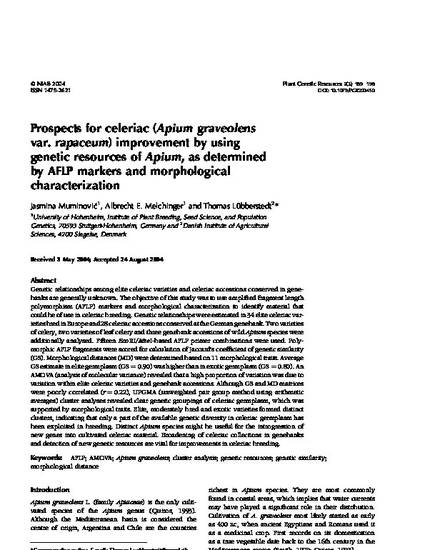
Article
Prospects for celeriac (Apium graveolens var. rapaceum) improvement by using genetic resources of Apium, as determined by AFLP markers and morphological characterization
Plant Genetic Resources
(2004)
Abstract
Genetic relationships among elite celeriac varieties and celeriac accessions conserved in genebanks
are generally unknown. The objective of this study was to use amplified fragment length
polymorphism (AFLP) markers and morphological characterization to identify material that
could be of use in celeriac breeding. Genetic relationships were estimated in 34 elite celeriac varieties
bred in Europe and 28 celeriac accessions conserved at the Germangenebank.Twovarieties
of celery, two varieties of leaf celery and three genebank accessions of wild Apium species were
additionally analysed. Fifteen Eco RI/Mse I-based AFLP primer combinations were used. Polymorphic
AFLP fragments were scored for calculation of Jaccard’s coefficient of genetic similarity
(GS). Morphological distances (MD) were determined based on 11 morphological traits. Average
GS estimate in elite germplasm (GS ¼ 0.90) was higher than in exotic germplasm (GS ¼ 0.80). An
AMOVA (analysis of molecular variance) revealed that a high proportion of variation was due to
variation within elite celeriac varieties and genebank accessions. Although GS and MD matrices
were poorly correlated (r ¼ 0.22), UPGMA (unweighted pair group method using arithmetic
averages) cluster analyses revealed clear genetic groupings of celeriac germplasm, which was
supported by morphological traits. Elite, moderately bred and exotic varieties formed distinct
clusters, indicating that only a part of the available genetic diversity in celeriac germplasm has
been exploited in breeding. Distinct Apium species might be useful for the introgression of
new genes into cultivated celeriac material. Broadening of celeriac collections in genebanks
and detection of new genetic resources are vital for improvements in celeriac breeding.
Keywords
- AFLP,
- AMOVA,
- Apium graveolens,
- cluster analysis,
- genetic resources,
- genetic similarity,
- morphological distance
Disciplines
Publication Date
2004
Publisher Statement
Published as Muminović, Jasmina, Albrecht E. Melchinger, and Thomas Lübberstedt. "Prospects for celeriac (Apium graveolens var. rapaceum) improvement by using genetic resources of Apium, as determined by AFLP markers and morphological characterization." Plant Genetic Resources 2, no. 3 (2004): 189-198.
Citation Information
Jasmina Muminovic, Albrecht E. Melchinger and Thomas Lubberstedt. "Prospects for celeriac (Apium graveolens var. rapaceum) improvement by using genetic resources of Apium, as determined by AFLP markers and morphological characterization" Plant Genetic Resources Vol. 2 Iss. 3 (2004) p. 189 - 198 Available at: http://works.bepress.com/thomas-lubberstedt/18/
